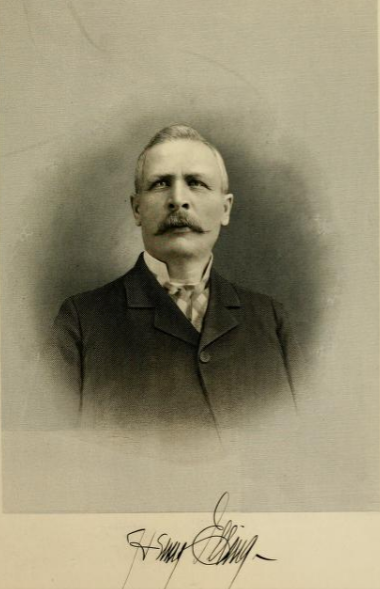House History
Henry Elling
The Beginning
Sitting near the east end of Idaho Street is one of Virginia City’s stately old mansions… the Elling House. And while not many of his contemporaries may have enjoyed the company of Henry Elling, many area residents have delighted in his wonderful home. The construction of the house was contracted by Elling in 1876, upon a portion of the approximately 26 1/2 city lots which he purchased for $65. Given Henry’s reputation, it is reasonable to assume that he got the best of the deal.
Henry Ellling was born in Germany in 1842, and was orphaned by the age of 15. In 1859, Henry came to the United States to live with an older brother who had previously emigrated to Missouri. Henry worked with his brother in mercantile sales, gaining valuable sales experience and learning English. Henry struck out on his own and was working in Denver in early 1864, when he learned of the new gold fields in a place called Virginia City. Henry arrived in Virginia City in early autumn with a supply of goods, and opened his clothing and general mercantile store on Wallace Street; a few doors below Content’s Corner.
After an early financial set-back due to an unscrupulous partner, Elling not only recovered, but prospered. Perhaps it was this incident which galvanized Henry into becoming a “hard-nosed” businessman who seldom, if ever, failed to turn a profit… or made a friend. In 1873, he opened a bank (at the corner of Wallace & Van Buren streets) quire over the next several years throughout Montana. He also invested widely and wisely in mining and agriculture enterprises, including the Silver Creek grist mill. Most would agree, however, that Henry’s most impressive (and surprising) acquisition was the hand of a bright and attractive young schoolteacher, Mary Cooley.
Mary Cooley was born in Vermont in 1848, but her family moved soon afterwards to Iowa. In 1868, her family moved to the Madison Valley of Montana; near Ennis. after briefly working as a teacher, Mary became the bride of Henry Elling on July 20, 1870, and moved to Virginia City. Mary would subsequently become the mother of ten children (3 of whom died in early childhood), she was a tireless volunteer to church and community activities, and she assumed the supervision of building and furnishing the family’s elegant home. Through it all her only consistent assistance in caring for her large family appears to have been a Chinese cook and, in later years, a live-in maid.
The original home was built using stone from the nearby quarry, and features three elegant Gothic windows. The interior of the original portion of the house includes a huge stone fireplace and beautiful oak floors and wood work. The property also included at least three additional out buildings on the property, and a double-seat outhouse.
Following Henry’s death, in November on 1900, Mary initiated an ambitious addition to the original home; doubling the size of the house. Included in the addition were a sitting room, smoking room, maid’s quarters, an additional (summer) kitchen, and perhaps most significantly a large formal dining/ballroom. The ballroom became a popular gathering spot where Mary hosted musical and artistic presentations for the Virginia City community.
Mary continued to live in the home until her death, on Christmas Day, in 1924. Afterwards , the home was sold by the family and subsequently used as a boarding house until 1947, before going vacant. Charles Bovey acquired the Elling property in 1953, and used the home for storage during the next several years. As one can readily imagine the house fell into significant disrepair from these several years of neglect. Toni James purchased the property in 1995, and began a loving, laborious and seemingly never-ending restoration of the house and property. The house has been designated as a “Contributing Property” in the National Register of Historic Places.
In November of 2008, with the gracious support of Ms. James and the leadership of Jack Waller, the Elling House Arts & Humanities Center was formed as a non-profit entity and it leased a portion of the property and home. Through the generous support of its members, the Center has restored the wonderful tradition established by Mary Elling by using the Elling House as a venue to show case artists, musicians, and authors through year-round programs open to the community to enjoy.
We think Mary would be very pleased… we’re not so sure about Henry.
Gary R. Forney - Nuggets In Time
